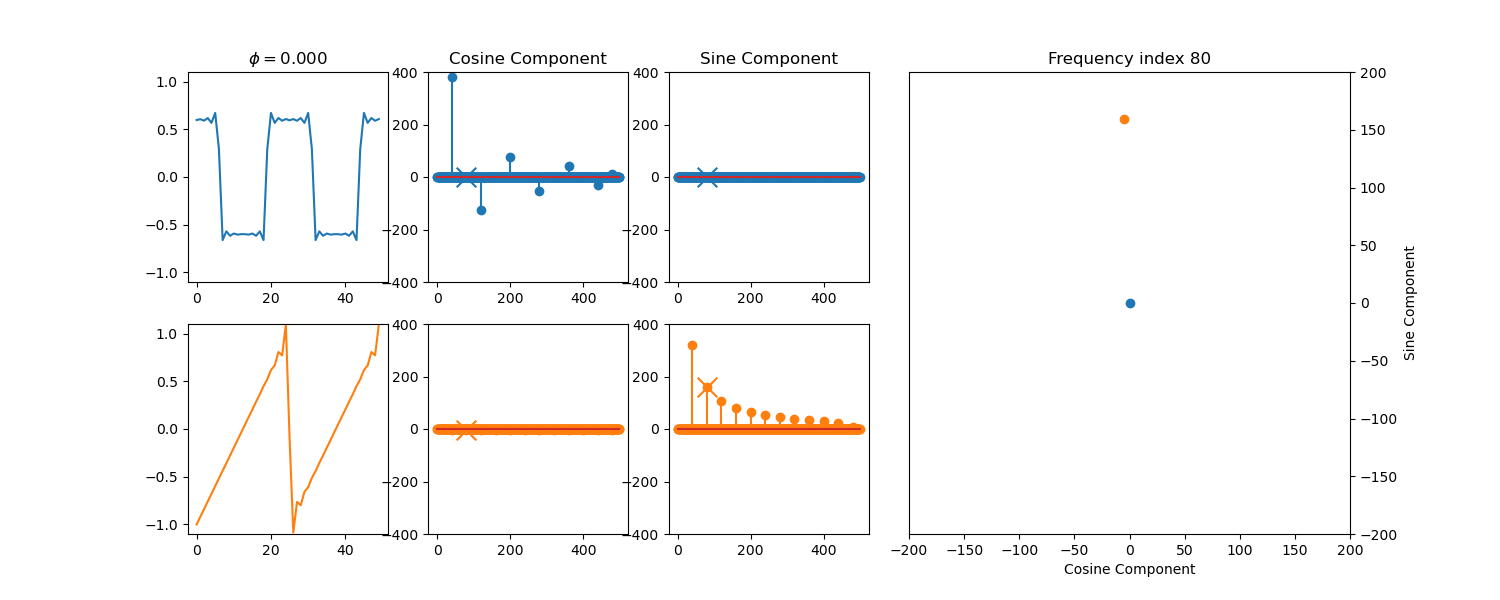sr = 8000 # Sample rate
N = 1000 # Number of audio samples per clip
n_frames = 150
fac = 1
plt.figure(figsize=(fac*15, fac*6))
T = 25 # Period
f = sr//25
idx = 2*f*N//sr
cidx1 = []
sidx1 = []
cidx2 = []
sidx2 = []
ylims = [-400, 400]
for i, phi in enumerate(np.linspace(0, np.pi, n_frames)):
plt.clf()
y1 = 0.6*get_square(1, f, phi, sr, N)
f1 = np.fft.fft(y1)[0:N//2]
y2 = get_sawtooth(1, f, phi, sr, N)
f2 = np.fft.fft(y2)[0:N//2]
cidx1.append(np.real(f1)[idx])
sidx1.append(np.imag(f1)[idx])
cidx2.append(np.real(f2)[idx])
sidx2.append(np.imag(f2)[idx])
plt.subplot(251)
plt.plot(y1[0:50])
plt.title("$\\phi = {:.3f}$".format(phi))
plt.ylim([-1.1, 1.1])
plt.subplot(252)
plt.stem(np.real(f1))
plt.scatter(idx, cidx1[-1], s=200, c='C0', marker='x')
plt.ylim(ylims)
plt.title("Cosine Component")
plt.subplot(253)
plt.stem(np.imag(f1))
plt.scatter(idx, sidx1[-1], s=200, c='C0', marker='x')
plt.ylim(ylims)
plt.title("Sine Component")
plt.subplot(256)
plt.plot(y2[0:50], c='C1')
plt.ylim([-1.1, 1.1])
plt.subplot(257)
markerline, stemlines, baseline = plt.stem(np.real(f2))
plt.setp(markerline, 'color', 'C1')
plt.setp(stemlines, 'color', 'C1')
plt.scatter(idx, cidx2[-1], s=200, c='C1', marker='x')
plt.ylim(ylims)
plt.subplot(258)
markerline, stemlines, baseline = plt.stem(np.imag(f2))
plt.setp(markerline, 'color', 'C1')
plt.setp(stemlines, 'color', 'C1')
plt.scatter(idx, sidx2[-1], s=200, c='C1', marker='x')
plt.ylim(ylims)
plt.subplot2grid((2, 5), (0, 3), rowspan=2, colspan=2)
plt.scatter(cidx1, sidx1)
plt.scatter(cidx2, sidx2)
plt.xlim(-200, 200)
plt.ylim(-200, 200)
plt.title("Frequency index {}".format(idx))
plt.xlabel("Cosine Component")
plt.ylabel("Sine Component")
plt.gca().yaxis.set_label_position("right")
plt.gca().yaxis.tick_right()
plt.savefig("shift{}.png".format(i))
